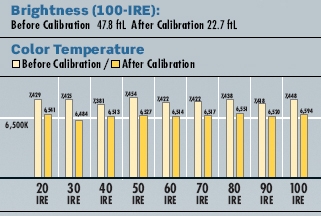Projectiondesign Avielo Optix Page 3

TEST BENCH
Color temperature (Preset mode before/User memory after calibration): 0-IRE: 7,437 K/6,575 K 10-IRE: 7,370 K/6,472 K 20-IRE: 7,429 K/6,541 K 30-IRE: 7,425 K/6,484 K 40-IRE: 7,381 K/6,513 K 50-IRE: 7,454 K/6,527 K 60-IRE: 7,422 K/6,514 K 70-IRE: 7,422 K/6,517 K 80-IRE: 7,438 K/6,551 K 90-IRE: 7,418 K/6,520 K 100-IRE: 7,448 K/6,594 K Brightness (100-IRE full field): 47.8/22.7 ftL
Primary Color Point Accuracy vs. SMPTE HD Standard
| Color | Target X | Measured X | Target Y | Measured Y |
| Red | 0.64 | 0.64 | 0.33 | 0.34 |
| Green | 0.30 | 0.30 | 0.60 | 0.60 |
| Blue | 0.15 | 0.16 | 0.06 | 0.07 |
The Avielo Optix is designed for professional calibration by a trained dealer, using a procedure that differs substantially from that used for most home projectors. With most projectors, the technician measures various parameters, fusses with the controls, measures the parameters again, and repeats the process until the results come close to ideal standards. With the Optix, the technician first measures red, green, and blue color points and luminance values, performs some calculations, and enters the results into the projector. He or she then measures the luminance value of red, green, blue, cyan, yellow, magenta, and white, performs more calculations, and enters those results into the projector. With that, calibration is finished. Although it is possible to calibrate the projector using normal methods, all Projectiondesign dealers are trained in the latter process, in large part because it removes human judgment from the operation. Thus, I decided to use it. At Projectiondesign's suggestion, I used SpectraCal's CalMAN software to perform the measurements and calculations. Once I loaded the software, set up the gear, and learned the process, grayscale and color calibration took less than 10 minutes - and required no more skill than entering numbers into a spreadsheet.
The Optix has a 6,500-K color temperature mode, but it doesn't measure any better than the Preset mode, in which grayscale tracking before calibration averaged 7,422 K from 0 to 100 IRE. That's a pretty long way from the 6,500-K standard, but the tracking was outstanding; the results varied from the average by at most 52°. After calibration, the grayscale tracking was practically perfect, averaging 6,528 K and varying from 6,500 K by at most 94 degrees.
Color decoder errors through the HDMI and component inputs were minor; with both inputs, red and blue were right on, and green was down about 5%. After calibration, the set's red, green, and blue primary color points almost perfectly matched the SMPTE HD specification for digital TV colors. The results are actually closer than the chart would indicate, because the tiny variances from standard that you can see are the result of rounding up to the nearest 0.01.
At Projectiondesign's suggestion, I calibrated the projector for my light-controlled home theater environment with the two lamps in economy mode, and the iris closed to the point where the projector delivered about 22 fL of brightness from a 100-IRE pure-white field. After calibration, the projector delivered a contrast ratio of 2,274:1. Out of curiosity, I measured the contrast in single-lamp mode, which yielded a somewhat better result of 3,267:1. (The advantage of using both lamps, rather than a single lamp, in economy mode is that you can switch from low-brightness mode to high-brightness mode almost instantly rather than wait 2 minutes for the second lamp to warm up. Using a single lamp delivers a better picture in a darkened environment, and of course prolongs the life of the unused lamp.) These numbers are okay but not great. However, the projector's high brightness in dual-lamp mode made the somewhat elevated black level much less noticeable; when I was watching normal program material, the black level seemed subjectively quite good. In "full blast" mode, with both lamps running at 100% and the iris opened all the way, luminance measured a blistering 92.6 fL, with a contrast ratio of 1,102:1.
The projector offers six gamma presets: two each for film, video, and computer. I found that the factory setting of Film 2.2 looked great for most movies. The Optix offers no overscan adjustment. Overscan measured 0% from the HDMI input and about 1.5% from the component-video input. The projector displayed 1080i/p and 720p test patterns with full resolution on both the HDMI and component-video connections.
Strangely, the sharpness is factory-preset at 16 on a scale of 20, a level that produces considerable ringing (white halos at the edge of on-screen objects). Most sharpness controls deliver best results at 0 or a very low setting, but this one dulls the picture at those settings. I found that a setting of 12 delivered the sharpest picture without ringing. Brightness uniformity was good, except for a slight dimming on the right side of the picture when I put up a 100-IRE field. (I didn't notice this characteristic with normal program material.) Color uniformity was excellent, with no noticeable color shift across the screen. A crosshatch pattern showed zero convergence error.
The projector easily passed every test from the DVD and Blu-ray versions of the Silicon Optix HQV Benchmark disc. It did a superb job of deinterlacing 1080i and 480i, especially on the HQV Benchmark's film-resolution test pattern, where it delivered a picture utterly free of the judder and artifacts that most projectors suffer with this test. Jaggies performance was outstanding at all resolutions. The noise reduction was moderately effective at the factory preset of 3 (on a scale of 31), with no visible softening of the image. Higher settings reduced noise to invisibility but softened the image considerably.
Fan noise is high, comparable to that of a large tower computer, and the fan's hot exhaust can be felt at a distance of 8 feet. This projector must be mounted in a soffit or box to deliver an acceptable audio noise level for home theater applications.
- Log in or register to post comments




















































